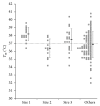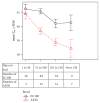Genetics of Marbling in Wagyu Revealed by the Melting Temperature of Intramuscular and Subcutaneous Lipids
- PMID: 29201894
- PMCID: PMC5672612
- DOI: 10.1155/2017/3948408
Genetics of Marbling in Wagyu Revealed by the Melting Temperature of Intramuscular and Subcutaneous Lipids
Abstract
Extreme marbling or intramuscular deposition of lipid is associated with Wagyu breeds and is therefore assumed to be largely inherited. However, even within 100% full blood Wagyu prepared under standard conditions, there is unpredictable scatter of the degree of marbling. Here, we evaluate melting temperature (Tm ) of intramuscular fat as an alternative to visual scores of marbling. We show that "long fed" Wagyu generally has Tm below body temperature but with a considerable range under standardized conditions. Individual sires have a major impact indicating that the variation is genetic rather than environmental or random error. In order to measure differences of lower marbling breeds and at shorter feeding periods, we have compared Tm in subcutaneous fat samples from over the striploin. Supplementary feeding for 100 to 150 days leads to a rapid decrease in Tm of 50% Red Wagyu (Akaushi) : 50% European crosses, when compared to 100% European. This improvement indicates that the genetic effect of Wagyu is useful, predictable, and highly penetrant. Contemporaneous DNA extraction does not affect the measurement of Tm . Thus, provenance can be traced and substitution can be eliminated in a simple and cost-effective manner.
Figures




References
-
- Cheng W., Cheng J. H., Sun D. W., Pu H. Marbling Analysis for Evaluating Meat Quality: Methods and Techniques. Comprehensive Reviews in Food Science and Food Safety. 2015;14(5):523–535. doi: 10.1111/1541-4337.12149. - DOI
-
- Johnson D. D., Savell J. W., Stiffler D. M., Cross H. R. Postmortem environmental factors affecting beef carcass lean maturity and marbling evaluations. Journal of Food Quality. 1986;8:253–264. doi: 10.1111/j.1745-4557.1986.tb00773.x. - DOI
-
- Kuchida K., Kono S., Konishi K., Van Vleck L. D., Suzuki M., Miyoshi S. Prediction of crude fat content of longissimus muscle of beef using the ratio of fat area calculated from computer image analysis: Comparison of regression equations for prediction using different input devices at different stations. Journal of Animal Science. 2000;78(4):799–803. doi: 10.2527/2000.784799x. - DOI - PubMed
-
- De Smet S., Raes K., Demeyer D. Meat fatty acid composition as affected by fatness and genetic factors: a review. Animal Research. 2004;53(2):81–98. doi: 10.1051/animres:2004003. - DOI
LinkOut - more resources
Full Text Sources
Other Literature Sources

